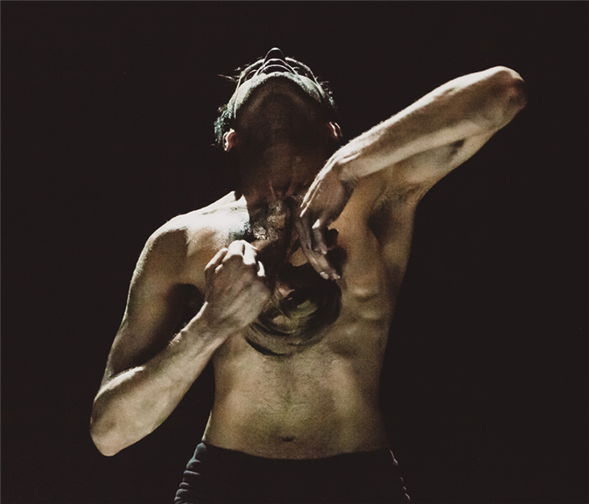Translate Page

Gotham finally gets a full performance from Aakash Odedra
---
New York has a lot of catching up to do when it comes to the uniquely eloquent, powerfully focused dancer/choreographer Aakash Odedra. While earlier this month he premiered his third complete solo program in England, next week's performances of Inked and Murmur will mark the first time he's presented a full evening of work here.
The 31-year-old British native, who was born and raised in Birmingham and whose grandparents were Indian, is highly trained in the classical Indian dance forms of Kathak and Bharatanatyam. However, he has sought out a range of contemporary choreographers to create powerfully resonant solos in which he merges styles, connecting with his heritage while confronting personal and philosophical issues. He's an adventurous performer for whom dance seems to be a mix of experiment, investigation, and catharsis.
Rising, the four-part 2011 program that put him on the map, has been seen – and rapturously received – everywhere from London to Sydney to Toronto. But until now, our only glimpses of Odedra in Gotham have been two tantalizingly brief pieces. In 2013, he appeared at the Apollo on a program of varied choreography set to James Brown's music. His solo, Ecstasy, found unexpected common ground between Kathak and Sufi moves and the Godfather of Soul. It also won him a Bessie Award.
Last year he again created a sensation with a few minutes of stage time when he performed Nritta, a primarily traditional solo he choreographed as the first section of Rising, at the Fall for Dance Festival. His precision, intensity, and fluidity combined for a performance that was riveting and memorable.
Now we can finally have a more complete Aakash Odedra experience. His program is being presented October 22-24 at the Baryshnikov Arts Center as part of Lincoln Center's White Light Festival.
Speaking by phone from England two days after his latest U.K. premiere, Odedra says, "I call my productions my 'university.' I never trained in contemporary dance, and for my first production, I had works by Akram Khan, Sidi Larbi, and Russell Maliphant. Never having done any contemporary dance, it was a huge jump.
"Kathak means storytelling, and that's how we're trained – to be able to mime, to be able to evoke an emotion from the person who's sitting in front of you," he continues, focusing on the rhythmically intense Indian style that features flurries of sharp, quick footwork. "There's a sense of storytelling. So whenever we're dancing, even if it's very abstracted, it still has a sense of story which is bubbling internally inside us."
While growing up in England, he regularly made extended family visits to India. "I used to live on a farm there, in the middle of nowhere. India was very different back then, when I was seven. TV was a far-off thing. Electricity wasn't always there. But now, for me, it turns out to be an amazing privilege. When you really are able to be in an environment where you are hands-on, the sense of touch, smell, sound, taste never leaves you. It's something that imprints in your mind. So spending time in India, for me, really enhanced my sense of identity and art – the sense of belonging, as well."
Once he was older and had become seriously interested in dance, he spent two years training in India. And he retains a close bond with his earliest teacher in England. "In Indian classical dance, once you form a relationship with your teacher, she isn't just your teacher. [She] becomes your guru – someone who takes a responsibility for you as a human being. The relationship never really ends. So even now, we will call and text each other about four times a week."
Just listening to Odedra speak about the program he's performing can be thought-provoking. Inked, created with the French/Belgian choreographer Damien Jalet, was initially inspired by the passing of Odedra's grandmother – his last memory of her, holding her hand during her final moments.
"My hand was clear, and hers was inked. That was something I grabbed onto – an image that stayed in my mind," he says. "So one of the subjects we took was that the body is not permanent, that you leave behind this imprint in life. I always say that I knock on the doorstep of death in that piece. You literally have to take yourself to that point of tipping over the edge."
For Murmur, which he choreographed with the Australian Lewis Major, Odedra incorporated a multimedia component, collaborating with Ars Electronica Futurelab as a means to explore his experiences with dyslexia. He's been altering and refining the piece, and shortly before the New York performances, he was adding further revisions, estimating with a weary laugh that this will be the fifth version.
"In terms of its dramaturgy, I thought things were too precise, in many ways. I think we needed to bring in the chaos of dyslexia, to find order," he says. "There's always a sense of order that you find in any chaos, [but] the piece had too much order in it. There wasn't a balance of the chaos and the order together, so we put a bit of chaos into the piece."
---
Susan Reiter regularly covers dance for TDF Stages.
Photos by Sean Goldthorpe
TDF Members: Click here to see all our available discounted performances.